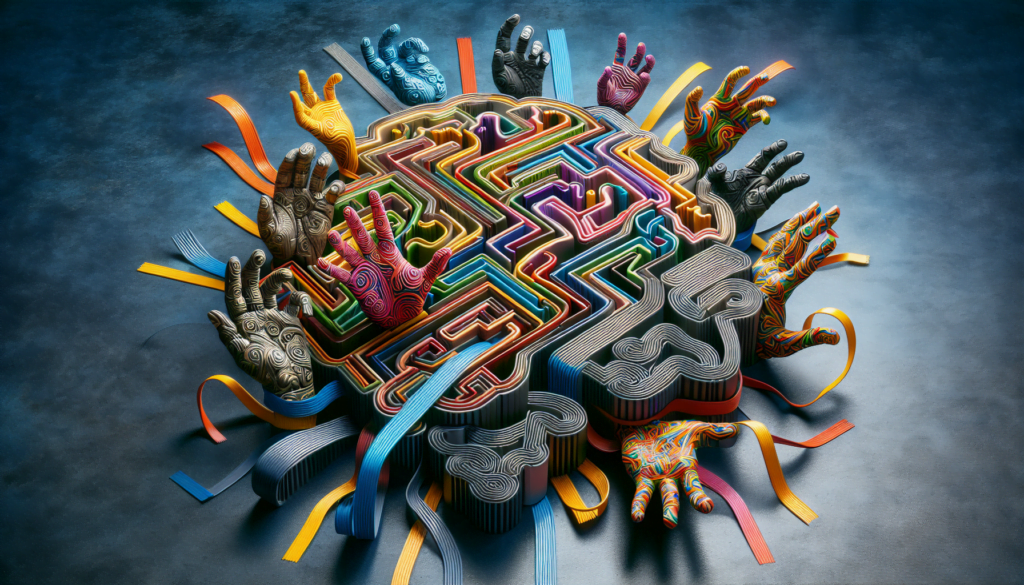Patterns of thoughts, feelings, and behaviors are like the threads that weave the fabric of our personalities. These enduring patterns are crucial to understanding why we act the way we do and how we relate to the world around us. For anyone looking to gain insight into their own psyche or seeking to comprehend the complexities of human behavior, this exploration is not just fascinating—it’s essential.
Key Takeaways
- Enduring patterns of thoughts, feelings, and behaviors are central to the study of personality disorders.
- The Five-Factor Model provides a comprehensive framework for understanding personality traits.
- Personality traits exhibit both stability and change over the lifespan.
- The Person-Situation Debate explores the consistency of behaviors across different situations.
- Borderline Personality Disorder (BPD) exemplifies the profound impact personality disorders can have on an individual’s life.
- Effective diagnosis and treatment strategies are vital for managing personality disorders.
- Beyond the Five-Factor Model, other traits contribute to the enduring patterns of behavior.
Understanding Personality Disorders
Definition and Characteristics of Personality Disorders
Deviation from cultural expectations
Personality disorders are marked by a deviation from the cultural expectations of the individual’s environment. This deviation can lead to significant misunderstandings and conflicts in social interactions.
Pervasiveness and inflexibility
These disorders are pervasive and inflexible, manifesting across a wide range of situations and leading to rigid behavior patterns that can be difficult to change.
Onset in adolescence or early adulthood
Typically, personality disorders begin in adolescence or early adulthood, setting the stage for long-term patterns throughout a person’s life.
Stability over time
One of the defining features of personality disorders is their stability over time. These enduring patterns are consistent and long-lasting.
Distress or impairment caused by the disorders
Personality disorders often cause significant distress or impairment in social, occupational, or other important areas of functioning.

The Five-Factor Model of Personality
Explanation of the Five-Factor Model
The Five-Factor Model, also known as the Big Five personality traits, is a widely accepted framework for understanding personality. It includes five broad dimensions that capture most of the variation in human personality.
Openness to Experience
Openness to experience describes a person’s degree of intellectual curiosity, creativity, and preference for novelty and variety.
Conscientiousness
Conscientiousness reflects a person’s tendency to be organized, dependable, and show self-discipline.
Extraversion
Extraversion indicates how outgoing, energetic, and sociable an individual is.
Agreeableness
Agreeableness is the measure of a person’s tendency to be compassionate and cooperative rather than suspicious and antagonistic towards others.
Neuroticism
Neuroticism refers to the tendency to experience negative emotions, such as anger, anxiety, or depression.

Relationship Between Personality Traits and Enduring Patterns
Perceiving the environment
Each trait influences how individuals perceive their environment and thus contributes to enduring patterns of thought, feeling, and behavior.
Relating to others
Personality traits also affect how people relate to others, influencing their social interactions and relationships.
Thinking about oneself
How individuals think about themselves, including their self-image and self-esteem, is also shaped by these traits.
Developmental Changes in Personality Traits
Stability and Change in Personality Over the Lifespan
Traits that remain stable
Research suggests that while certain personality traits remain relatively stable throughout life, others may change as a result of life experiences and personal growth.
Traits that may change with age
For example, as people age, they often become less extraverted and open to experience but more agreeable and conscientious.

The Person-Situation Debate
Interaction Between Personality Traits and Situational Factors
Consistency of behaviors across different situations
The Person-Situation Debate centers on whether behavior is more influenced by personality traits or situational factors. It examines the consistency of behaviors across different contexts.
Alternatives to the trait perspective
Alternatives to the trait perspective include behaviorism and social-cognitive theories, which emphasize the role of learning and cognition in behavior.

Borderline Personality Disorder (BPD) as a Case Study
Characteristics of Borderline Personality Disorder
Instability in interpersonal relationships
BPD is characterized by instability in interpersonal relationships, self-image, and affects, as well as marked impulsivity.
Distorted self-image
Individuals with BPD often struggle with a distorted self-image and a persistent sense of emptiness.
Intense emotional responses
They may experience intense emotional responses to stressors and have difficulty regulating these emotions.
Impulsivity
Impulsivity in BPD can lead to risky behaviors and self-harm.

Treatment Approaches for BPD
Psychotherapy
Psychotherapy, particularly dialectical behavior therapy (DBT), is a cornerstone of treatment for BPD.
Medication
While there is no medication specifically for BPD, certain medications can help manage symptoms.
Long-term outcomes
With appropriate treatment, many individuals with BPD can achieve stability and lead fulfilling lives.
Personal Reflections and Experiences with BPD
Impact on the individual’s life
The impact of BPD on an individual’s life can be profound, affecting every aspect of their personal and professional relationships.
Challenges in interpersonal dynamics
The challenges in interpersonal dynamics often require sustained effort and support to overcome.

The Impact of Personality Disorders on Life
Effects on Interpersonal Relationships
Personality disorders can significantly affect interpersonal relationships, often leading to conflict and misunderstanding.
Influence on Self-Image and Identity
These disorders can also influence an individual’s self-image and identity, sometimes resulting in a distorted sense of self.
Emotional and Behavioral Consequences
The emotional and behavioral consequences of personality disorders can be wide-ranging and deeply affect an individual’s quality of life.

Diagnosis and Treatment Strategies
Diagnostic Criteria for Personality Disorders
Clinical assessment
Clinical assessment is crucial for diagnosing personality disorders, often involving a combination of interviews, self-report questionnaires, and observation.
Differential diagnosis
Differential diagnosis is important to distinguish personality disorders from other mental health conditions.
Therapeutic Interventions
Cognitive-behavioral therapy (CBT)
Cognitive-behavioral therapy (CBT) is an effective treatment for many personality disorders, helping individuals to recognize and change maladaptive thought patterns.
Dialectical behavior therapy (DBT)
DBT, a form of CBT, is particularly effective for treating BPD and other disorders characterized by emotional dysregulation.
Other psychotherapeutic modalities
Other psychotherapeutic modalities, such as psychodynamic therapy and group therapy, can also be beneficial.

Exploring Other Traits Beyond the Five-Factor Model
Additional Personality Traits and Their Stability
Examples of traits not covered by the Five-Factor Model
There are additional personality traits not covered by the Five-Factor Model that also contribute to enduring patterns of behavior.
Their role in enduring patterns of behavior
These traits, such as resilience and self-regulation, play a significant role in how individuals navigate their lives and relationships.
Theoretical Perspectives on Enduring Patterns
Trait Theory Versus Other Psychological Theories
Behaviorism
Behaviorism focuses on observable behaviors and the ways in which they are learned through interaction with the environment.
Social-cognitive theories
Social-cognitive theories emphasize the role of cognitive processes and reciprocal determinism in the development of personality.
Humanistic perspectives
Humanistic perspectives stress the importance of individual growth and self-actualization.
Conclusion
Summary of Enduring Patterns in Personality Disorders
The enduring patterns of thoughts, feelings, and behaviors are central to the concept of personality disorders, providing a framework for understanding the complexities of human personality.
The Importance of Understanding These Patterns
Understanding these patterns is crucial for clinical practice, helping professionals to diagnose and treat personality disorders effectively. It is also valuable for personal development and improving interpersonal relationships, as it offers insights into the nature of human behavior and the potential for change.
Unraveling the Mysteries of the Mind: An FAQ Journey into Enduring Patterns of Thoughts, Feelings, and Behaviors
What are enduring patterns of thoughts, feelings, and behaviors?
Enduring patterns of thoughts, feelings, and behaviors are consistent ways in which individuals perceive, relate to, and think about themselves and the world. These patterns are stable over time, and can significantly influence a person’s life, affecting their relationships, work, and overall well-being. They are often deeply ingrained and can be difficult to change without conscious effort or professional help.
How do these patterns form?
These patterns typically develop through a combination of genetic predispositions and environmental influences such as upbringing, culture, and life experiences. Early interactions with caregivers and significant life events play a crucial role in shaping these patterns. Over time, they become solidified into our personality and character, guiding our reactions and decisions on a subconscious level.
Can these patterns be changed?
Yes, while these patterns are enduring, they are not set in stone. Change is possible through various forms of therapy, self-reflection, and personal development efforts. Cognitive-behavioral therapy, for example, is designed to help individuals recognize and alter negative thought patterns and behaviors.
Why is it important to understand these patterns?
Understanding these patterns is crucial for self-awareness and personal growth. It allows individuals to identify areas in their lives that may be causing distress or dissatisfaction and to work towards improving them. Additionally, it can enhance empathy and communication in relationships by helping people understand the perspectives and behaviors of others.
Are these patterns related to mental health?
Yes, enduring patterns of thoughts, feelings, and behaviors are closely related to mental health. Maladaptive patterns can contribute to the development of mental health disorders, while healthy patterns can promote psychological well-being. Recognizing and addressing harmful patterns can be an important part of maintaining or improving mental health.
How do these patterns influence decision-making?
These patterns can significantly influence decision-making by affecting how we process information, weigh options, and anticipate outcomes. For instance, someone with a pessimistic thought pattern may consistently expect negative results and therefore make more cautious or risk-averse decisions, while an optimist might take more chances.
What role do emotions play in these patterns?
Emotions are integral to these patterns, as they often drive our behaviors and shape our thoughts. Emotional responses can reinforce certain patterns, particularly if they are intense or frequently experienced. For example, frequent anxiety can lead to avoidance behaviors, while regular experiences of joy might encourage social engagement.
Can culture affect these patterns?
Culture plays a significant role in shaping these patterns. It influences the norms, values, and beliefs that we adopt, which in turn affect how we think, feel, and behave. Cultural expectations can dictate acceptable ways of expressing emotions, handling stress, and interacting with others, all of which contribute to our individual patterns.
Is there a genetic component to these patterns?
Genetics can predispose individuals to certain patterns of thought, emotion, and behavior. For example, traits like temperament can be inherited and can influence how a person reacts to their environment from a young age. However, genetics is just one factor, and these patterns are usually the result of a complex interplay between genes and life experiences.
How can someone become more aware of their patterns?
Becoming more aware of one’s patterns often requires intentional self-reflection and mindfulness. Keeping a journal, engaging in therapy, and seeking feedback from trusted friends or family can help individuals gain insight into their patterns. Mindfulness practices can also help people become more aware of their moment-to-moment thoughts and feelings, providing opportunities to recognize and adjust their patterns.



